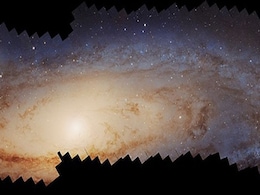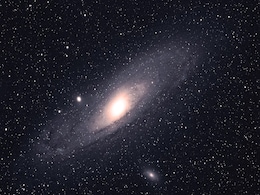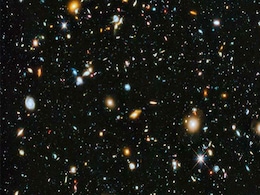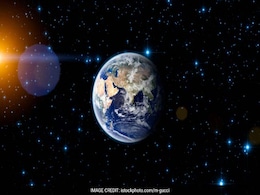Andromeda Galaxy
- All
- News
- Web Stories
-

Smallest Galaxy Ever Found: Andromeda XXXV Defies Cosmic Evolution Models
- Thursday March 13, 2025
- Written by Gadgets 360 Staff
Astronomers have discovered Andromeda XXXV, the smallest and faintest known galaxy, located 3 million light-years away. It challenges existing models of galaxy formation, as similar small galaxies were thought to be destroyed in the early universe. Researchers are studying how it retained conditions for star formation despite harsh cosmic environme...
-
 www.gadgets360.com
www.gadgets360.com
-

Hubble’s Detailed Andromeda Galaxy Mosaic Sheds Light on Its Past and Evolution
- Tuesday January 21, 2025
- Written by Gadgets 360 Staff
NASA’s Hubble Space Telescope has produced a massive photomosaic of the Andromeda galaxy, revealing more than 200 million stars. The study offers fresh insights into Andromeda’s evolutionary history, which includes mergers with smaller galaxies. This breakthrough provides a clearer picture of the galaxy's structure and the processes that shaped...
-
 www.gadgets360.com
www.gadgets360.com
-

ISRO’s AstroSat Observes First-Ever Nuclear Explosion in Andromeda Galaxy
- Tuesday December 10, 2024
- Written by Gadgets 360 Staff
Using the Ultraviolet Imaging Telescope (UVIT) aboard ISRO’s AstroSat, scientists have identified far-ultraviolet emissions from 42 novae in the Andromeda Galaxy. This marks the first detection of such emissions during their outbursts, offering new insights into the processes of stellar explosions. Four of these novae were observed in real-time a...
-
 www.gadgets360.com
www.gadgets360.com
-

Here's How James Webb Space Telescope Helps Us Look Back in Time
- Tuesday November 19, 2024
- Written by Gadgets 360 Staff
The James Webb Space Telescope allows astronomers to explore the universe’s history by observing light that has travelled across billions of light-years. This unique capability enables scientists to see how galaxies, stars, and other celestial bodies appeared billions of years ago, offering a glimpse into the early stages of the universe. By stud...
-
 www.gadgets360.com
www.gadgets360.com
-

Milky Way and Andromedia Fated Collision Might Not Happen, Reveals New Study
- Sunday August 25, 2024
- Gadgets 360 Staff
Recent research has cast doubt on the certainty of the Milky Way-Andromeda galaxy collision, suggesting the event may not be as inevitable as once thought. Traditionally, astronomers have predicted that our galaxy would merge with Andromeda within the next 5 billion years, creating a new elliptical galaxy often referred to as "Milkomeda." However, ...
-
 www.gadgets360.com
www.gadgets360.com
-

Pegasus V, Dwarf Galaxy Near Andromeda, Believed to Be One of the First Galaxies
- Thursday August 11, 2022
- Edited by Gadgets 360 Newsdesk
A team of astronomers at the University of Surrey recently found an extremely faint, dwarf galaxy which, they believe, is one of the first galaxies packed with a very old star. The galaxy, monikered as Pegasus V, is located in the vicinity of the Andromeda galaxy. The “fossil” galaxy that the team discovered has a high concentration of old star...
-
 www.gadgets360.com
www.gadgets360.com
-

NASA Shares Largest-Ever Image Of Andromeda Galaxy, Internet Calls It "Extraordinarily Beautiful"
- Tuesday August 2, 2022
- World News | Edited by Bhavya Sukheja
American space agency NASA on Sunday shared the "largest-ever" image assembled of the Andromeda galaxy by the Hubble Space Telescope. The picture was captured seven years ago and it is the sharpest large composite image ever taken of the galaxy.
-
 www.ndtv.com
www.ndtv.com
-

Scientists Use Retired Telescopes to Capture Intricate Images of Cosmic Dust and Clouds
- Saturday June 18, 2022
- Edited by Gadgets 360 Newsdesk
Scientists have captured intricate details of cosmic dust and clouds in space, including the Andromeda galaxy (M31), Triangulum galaxy (M33), and the Large and Small Magellanic Clouds. In order to create images of the cosmic dust and clouds, researchers have relied on data from various retired missions such as the using the European Space Agency (E...
-
 www.gadgets360.com
www.gadgets360.com
-

Andromeda Galaxy Zoom-Out Video With Over 100 Million Stars Will Leave You Awestruck
- Thursday June 10, 2021
- Edited by Gadgets 360 Newsdesk
Andromeda Galaxy's vastness is captured perfectly in a zoom-out video that was shared by World and Science, a Twitter handle that frequently shares interesting stories from the world of science. The video of Andromeda Galaxy, also known as Messier 31 or M31, has left users on the micro-blogging site awestruck.
-
 www.gadgets360.com
www.gadgets360.com
-

NASA Shares an Image of a ‘Cosmic Rose’. Here’s What It Is
- Thursday April 22, 2021
- Edited by Gadgets 360 Newsdesk
NASA Hubble Space Telescope Instagram account has shared a post with a stunning image of “interacting galaxies Arp 273”. The group of spiral galaxies seems to have created a shape resembling a “cosmic rose”.
-
 www.gadgets360.com
www.gadgets360.com
-

Andromeda Galaxy, on Collision Course With the Milky Way, Has a Cannibalistic History: Researchers
- Thursday October 3, 2019
- Indo-Asian News Service
Australian researchers have found that Andromeda, our neighbouring large galaxy, has a history of eating galaxies going back 10 billion years.
-
 www.gadgets360.com
www.gadgets360.com
-

This Violent Galaxy Next Door Is Set For A Collision With The Milky Way
- Thursday October 3, 2019
- Science | Indo-Asian News Service
Australian researchers have found that Andromeda, our neighbouring large galaxy, has a history of eating galaxies going back 10 billion years.
-
 www.ndtv.com
www.ndtv.com
-

Milky Way Galaxy Is ''Warped, Twisted'' Not Flat: Study
- Tuesday February 5, 2019
- Science | Indo-Asian News Service
The Milky Way's disk of stars is not stable or flat but instead becomes increasingly "warped" and twisted far away from the galaxy's centre, according to astronomers.
-
 www.ndtv.com
www.ndtv.com
-

NASA Telescope Finds Clues To Dark Matter At Andromeda Galaxy
- Wednesday February 22, 2017
- World News | Indo-Asian News Service
NASA's Fermi gamma-ray space telescope has found a signal at the centre of the neighbouring Andromeda galaxy that could be coming from dark matter, an unknown substance that makes up most of the universe, according to a study.
-
 www.ndtv.com
www.ndtv.com
-

Smallest Galaxy Ever Found: Andromeda XXXV Defies Cosmic Evolution Models
- Thursday March 13, 2025
- Written by Gadgets 360 Staff
Astronomers have discovered Andromeda XXXV, the smallest and faintest known galaxy, located 3 million light-years away. It challenges existing models of galaxy formation, as similar small galaxies were thought to be destroyed in the early universe. Researchers are studying how it retained conditions for star formation despite harsh cosmic environme...
-
 www.gadgets360.com
www.gadgets360.com
-

Hubble’s Detailed Andromeda Galaxy Mosaic Sheds Light on Its Past and Evolution
- Tuesday January 21, 2025
- Written by Gadgets 360 Staff
NASA’s Hubble Space Telescope has produced a massive photomosaic of the Andromeda galaxy, revealing more than 200 million stars. The study offers fresh insights into Andromeda’s evolutionary history, which includes mergers with smaller galaxies. This breakthrough provides a clearer picture of the galaxy's structure and the processes that shaped...
-
 www.gadgets360.com
www.gadgets360.com
-

ISRO’s AstroSat Observes First-Ever Nuclear Explosion in Andromeda Galaxy
- Tuesday December 10, 2024
- Written by Gadgets 360 Staff
Using the Ultraviolet Imaging Telescope (UVIT) aboard ISRO’s AstroSat, scientists have identified far-ultraviolet emissions from 42 novae in the Andromeda Galaxy. This marks the first detection of such emissions during their outbursts, offering new insights into the processes of stellar explosions. Four of these novae were observed in real-time a...
-
 www.gadgets360.com
www.gadgets360.com
-

Here's How James Webb Space Telescope Helps Us Look Back in Time
- Tuesday November 19, 2024
- Written by Gadgets 360 Staff
The James Webb Space Telescope allows astronomers to explore the universe’s history by observing light that has travelled across billions of light-years. This unique capability enables scientists to see how galaxies, stars, and other celestial bodies appeared billions of years ago, offering a glimpse into the early stages of the universe. By stud...
-
 www.gadgets360.com
www.gadgets360.com
-

Milky Way and Andromedia Fated Collision Might Not Happen, Reveals New Study
- Sunday August 25, 2024
- Gadgets 360 Staff
Recent research has cast doubt on the certainty of the Milky Way-Andromeda galaxy collision, suggesting the event may not be as inevitable as once thought. Traditionally, astronomers have predicted that our galaxy would merge with Andromeda within the next 5 billion years, creating a new elliptical galaxy often referred to as "Milkomeda." However, ...
-
 www.gadgets360.com
www.gadgets360.com
-

Pegasus V, Dwarf Galaxy Near Andromeda, Believed to Be One of the First Galaxies
- Thursday August 11, 2022
- Edited by Gadgets 360 Newsdesk
A team of astronomers at the University of Surrey recently found an extremely faint, dwarf galaxy which, they believe, is one of the first galaxies packed with a very old star. The galaxy, monikered as Pegasus V, is located in the vicinity of the Andromeda galaxy. The “fossil” galaxy that the team discovered has a high concentration of old star...
-
 www.gadgets360.com
www.gadgets360.com
-

NASA Shares Largest-Ever Image Of Andromeda Galaxy, Internet Calls It "Extraordinarily Beautiful"
- Tuesday August 2, 2022
- World News | Edited by Bhavya Sukheja
American space agency NASA on Sunday shared the "largest-ever" image assembled of the Andromeda galaxy by the Hubble Space Telescope. The picture was captured seven years ago and it is the sharpest large composite image ever taken of the galaxy.
-
 www.ndtv.com
www.ndtv.com
-

Scientists Use Retired Telescopes to Capture Intricate Images of Cosmic Dust and Clouds
- Saturday June 18, 2022
- Edited by Gadgets 360 Newsdesk
Scientists have captured intricate details of cosmic dust and clouds in space, including the Andromeda galaxy (M31), Triangulum galaxy (M33), and the Large and Small Magellanic Clouds. In order to create images of the cosmic dust and clouds, researchers have relied on data from various retired missions such as the using the European Space Agency (E...
-
 www.gadgets360.com
www.gadgets360.com
-

Andromeda Galaxy Zoom-Out Video With Over 100 Million Stars Will Leave You Awestruck
- Thursday June 10, 2021
- Edited by Gadgets 360 Newsdesk
Andromeda Galaxy's vastness is captured perfectly in a zoom-out video that was shared by World and Science, a Twitter handle that frequently shares interesting stories from the world of science. The video of Andromeda Galaxy, also known as Messier 31 or M31, has left users on the micro-blogging site awestruck.
-
 www.gadgets360.com
www.gadgets360.com
-

NASA Shares an Image of a ‘Cosmic Rose’. Here’s What It Is
- Thursday April 22, 2021
- Edited by Gadgets 360 Newsdesk
NASA Hubble Space Telescope Instagram account has shared a post with a stunning image of “interacting galaxies Arp 273”. The group of spiral galaxies seems to have created a shape resembling a “cosmic rose”.
-
 www.gadgets360.com
www.gadgets360.com
-

Andromeda Galaxy, on Collision Course With the Milky Way, Has a Cannibalistic History: Researchers
- Thursday October 3, 2019
- Indo-Asian News Service
Australian researchers have found that Andromeda, our neighbouring large galaxy, has a history of eating galaxies going back 10 billion years.
-
 www.gadgets360.com
www.gadgets360.com
-

This Violent Galaxy Next Door Is Set For A Collision With The Milky Way
- Thursday October 3, 2019
- Science | Indo-Asian News Service
Australian researchers have found that Andromeda, our neighbouring large galaxy, has a history of eating galaxies going back 10 billion years.
-
 www.ndtv.com
www.ndtv.com
-

Milky Way Galaxy Is ''Warped, Twisted'' Not Flat: Study
- Tuesday February 5, 2019
- Science | Indo-Asian News Service
The Milky Way's disk of stars is not stable or flat but instead becomes increasingly "warped" and twisted far away from the galaxy's centre, according to astronomers.
-
 www.ndtv.com
www.ndtv.com
-

NASA Telescope Finds Clues To Dark Matter At Andromeda Galaxy
- Wednesday February 22, 2017
- World News | Indo-Asian News Service
NASA's Fermi gamma-ray space telescope has found a signal at the centre of the neighbouring Andromeda galaxy that could be coming from dark matter, an unknown substance that makes up most of the universe, according to a study.
-
 www.ndtv.com
www.ndtv.com

















